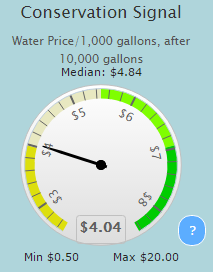
Written by: Evan Kirk
Evan Kirk is a student data analyst at the Environmental Finance Center.
During my first year at the Environmental Finance Center (EFC) I have worked on water and wastewater rate surveys in Georgia, Alabama, North Carolina, Arizona, Hawaii, and Connecticut. While uniform, block, and tiered rate structures are commonly used by water and wastewater utilities, seasonal uniform rate structures are rarely implemented.Within the previously mentioned six states, just six out of 1,879 water rate structures and one out of 1,179 wastewater rate structures utilize seasonal rates. Although all utilities with seasonal rates within these states have seasonal uniform rates, seasonal rates can also be used as part of an increasing block structure.
Seasonal water rate structures are designed to encourage conservation. Since distribution systems are designed to meet peak demands, conservation-oriented pricing ensures that users with high seasonal variation in water consumption pay for the infrastructure necessary to meet their demands. Seasonal rates can be effective because the increased volumetric cost of water may provide incentive for customers to reduce discretionary water use, such as lawn irrigation. This rate structure charges more for water in the summer months when discretionary water use is highest, which increases the conservation signal from low season to high season. The EFC uses this conservation signal to model the difference in the monthly water or wastewater bill between 10,000 and 11,000 gallons of use. Though the conservation signal has some limitations, it is a good place for utilities to start when analyzing how much their rate structure encourages or discourages discretionary water use. The EFC displays their conservation signal in annual and biannual water and wastewater rates dashboards for over a dozen states, displaying a dial comparing each utilities conservation signal to those of all the utilities in a comparison group.

Unlike typical utilities with seasonal water rates, the single wastewater utility that charges a seasonal rate structure among the six states actually charges less for wastewater in June, July, and August. This means rates are higher in the fall, winter, and spring than during the low rate season of summer—the opposite of the typical high season/low season dynamic for seasonal water rate structures. Since discretionary water uses like lawn irrigation, car washing, and recreation, are often outdoors, they do not increase demand on the sewer system. The underlying assumption is that a customer’s wastewater discharge, unlike water usage, does not fluctuate much from month to month. Utilities that provide both water and wastewater services may address this, where available, with irrigation meters that may or may not utilize unique rate structures (that often charge more than regular water use) to ensure that the customer is not charged for wastewater services as a result of outdoor discretionary water use. Additionally, many wastewater only utilities charge customers based on their winter quarter water usage.
Not only are seasonal water rates are a great way to encourage conservation during peak seasons, but utilities with large seasonal variations that do not offer irrigation meters may benefit from employing seasonal rates. In addition, seasonal wastewater rates could ensure customers are not charged for wastewater services for water that does not enter the sewer system, suggesting wastewater utilities that serve customers that do not have separate irrigation meters may consider seasonal wastewater rates.

